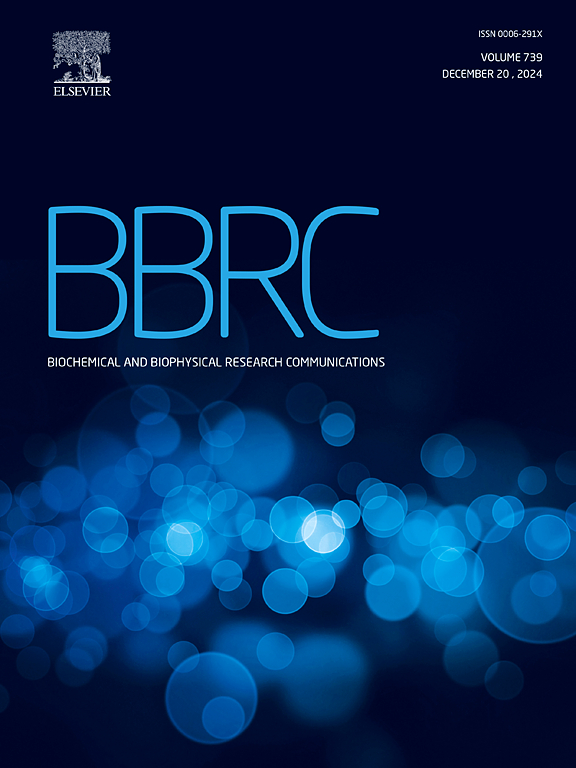Effect of resveratrol and quercetin on SFRP4 as a biomarker of diabesity: In silico and in vivo studies
IF 2.5
3区 生物学
Q3 BIOCHEMISTRY & MOLECULAR BIOLOGY
Biochemical and biophysical research communications
Pub Date : 2025-04-02
DOI:10.1016/j.bbrc.2025.151748
引用次数: 0
Abstract
The concurrent presence of complex metabolic disorders such as obesity and diabetes within an individual is known as diabesity. Various organs are involved in metabolic chronic diseases like obesity, hypertension, and diabetes. In the last few years, the rise in diabetes cases has coincided with the rapid elevation in obesity rates, resulting in a global health crisis. Major risk factors playing a critical role in the spread of obesity include high-fat food consumption, high-calorie foods, and insufficient physical activity. Diabetes is strongly linked with obesity in terms of metabolic abnormalities and physiological processes, including inflammation. Diabetes type 2 (T2D) is caused primarily by insulin resistance and insufficient insulin release from beta cells of the pancreas. An obese or overweight individual has a strong association with insulin resistance, which in turn leads to the development of T2D. Metabolic stress due to nutrient overload releases different types of inflammatory mediators (such as TNF-α, IL-6, and SFRP4) from adipose tissues in obesity. Secreted frizzled-related protein 4 (SFRP4) is also an inflammatory mediator that impairs insulin secretion. SFRP4 acts as an early biomarker for diabesity expressed with interleukin-1 beta (IL-1β) in the adipose tissues that hinders the exocytosis of insulin-secreting granules from the pancreatic β-cells and is a potential target for preserving β-cell dysfunction and the diabesity treatment. In the current study, plant-based phytocompounds were identified and investigated in silico and in vivo for their ability to suppress the expression of SFRP4. In a diet-induced mouse model, short-listed compounds such as resveratrol and quercetin at higher and lower doses were found effective and significant in reducing the anti-inflammatory mediators and SFRP4 levels. Overall, the current study describes the expression of SFRP4, IL-6, and TNF-α, and its inhibition by various inhibitors. Moreover, the study's findings suggest that resveratrol and quercetin hold promise as potential treatments for diabesity.

白藜芦醇和槲皮素对糖尿病生物标志物SFRP4的影响:计算机和体内研究
一个人同时存在复杂的代谢紊乱,如肥胖和糖尿病,被称为糖尿病。肥胖、高血压和糖尿病等代谢性慢性疾病涉及多种器官。在过去几年中,糖尿病病例的增加与肥胖率的迅速上升同时发生,导致全球健康危机。在肥胖蔓延中起关键作用的主要风险因素包括高脂肪食物的摄入、高热量食物和缺乏体育锻炼。糖尿病在代谢异常和包括炎症在内的生理过程方面与肥胖密切相关。2型糖尿病(T2D)主要由胰岛素抵抗和胰腺β细胞胰岛素释放不足引起。肥胖或超重的个体与胰岛素抵抗有很强的联系,这反过来又导致了T2D的发展。由于营养超载引起的代谢应激从肥胖的脂肪组织中释放不同类型的炎症介质(如TNF-α, IL-6和SFRP4)。分泌卷曲相关蛋白4 (SFRP4)也是一种损害胰岛素分泌的炎症介质。SFRP4作为糖尿病的早期生物标志物,在脂肪组织中通过白细胞介素-1β (IL-1β)表达,阻碍胰腺β细胞分泌胰岛素颗粒,是保护β细胞功能障碍和糖尿病治疗的潜在靶点。在目前的研究中,基于植物的植物化合物被鉴定并在硅和体内研究了它们抑制SFRP4表达的能力。在饮食诱导的小鼠模型中,发现高剂量和低剂量的白藜芦醇和槲皮素等候选化合物在降低抗炎介质和SFRP4水平方面有效且显著。总体而言,本研究描述了SFRP4、IL-6和TNF-α的表达,以及各种抑制剂对其的抑制作用。此外,研究结果表明,白藜芦醇和槲皮素有望成为治疗糖尿病的潜在药物。
本文章由计算机程序翻译,如有差异,请以英文原文为准。
求助全文
约1分钟内获得全文
求助全文
来源期刊
CiteScore
6.10
自引率
0.00%
发文量
1400
审稿时长
14 days
期刊介绍:
Biochemical and Biophysical Research Communications is the premier international journal devoted to the very rapid dissemination of timely and significant experimental results in diverse fields of biological research. The development of the "Breakthroughs and Views" section brings the minireview format to the journal, and issues often contain collections of special interest manuscripts. BBRC is published weekly (52 issues/year).Research Areas now include: Biochemistry; biophysics; cell biology; developmental biology; immunology
; molecular biology; neurobiology; plant biology and proteomics

 求助内容:
求助内容: 应助结果提醒方式:
应助结果提醒方式:


